
Greece has a century-old cheese-making tradition, with a wide range of more than 100 Greek cheese varieties. Greek cheeses are considered among the finest in the world.
Here we present you the most popular, well-known, and tasteful varieties of Greek cheeses.

Feta is the most famous traditional Greek cheese, dating back to the Homeric ages. It is a white soft cheese, ripened and kept in brine for at least two months. It has been and still remains a significant part of Greek diet and its name is often connected with the Greek history and tradition. The average (per capita) annual consumption of Feta in Greece is more than 12 Kg, out of a total cheese consumption of 25 Kg, which is the highest in the world.
Feta is a cheese with Protected designation of Origin (PDO) manufactured from pure ewe's milk or a mixture with up to 30% of goat's milk in the regions of Macedonia, Thrace, Epirus, Thessalia, Sterea Hellas, Peloponnesus and Mitilini island. It has salty, slightly acid taste, natural white colour and pleasant organoleptic characteristics. Feta is manufactured mainly in mountainous and semi- mountainous regions of Greece where the use of any harmful substances (fertilizers, pesticides etc.) is very scarce. It is distributed to the market in barrels, in tin boxes or in the form of plastic-wrapped pieces and is consumed as table cheese, in the famous Greek salad. in cheese-pastries and quite often as saganaki (shallow-fried cheese). The average composition of Feta is: moisture 52.9%, fat 26.2%, proteins 16,7%, salt 2.9% and pH 4.4. The regulation 1107/96 initially registered Feta cheese as Protected Designation of Origin (P.D.O.) under the conditions enforced by the regulation 2081/92 EU of the requirements that should be met so that any product bears the name of origin.. An abrogative decision of this regulation from the European Court of Justice was published following the reactions of producers from other countries that manufactured imitation Feta cheese. After the valid appeal of Greek parties, the name Feta has been permanently registered as Protected Designation of Origin (P.D.O.) according to the decision 314/14-6-2002 of the Commission.

This is a generic category, describing traditional cheese, which is, due to its unique texture ideal for frying. They come in vacuum pack, in prolonged round shape with a distinct flavor from ewe’s and sheep milk.

Anthotiros is traditional Greek whey cheese with Protected designation of Origin (PDO). It has been manufactured in Greece for many centuries from whey of ewe’s and goat’s milk or mixtures, with the addition of small quantities of milk and/or cream, in the regions of Macedonia, Thrace, Thessalia, Sterea Hellas, Peloponnesus, Ionian islands, Aegean islands, Crete island and Epirus. There are two types of Anthotiros: Fresh and Dried. Fresh Anthotiros has soft texture, mild taste, very pleasant organoleptic properties, and is consumed as table cheese or used in the preparation of cheese-pastries. Dried Anthotiros has hard texture, salty taste, a very rich flavor and is consumed as grated or table cheese. Fresh Anthotiros contains up to 70% moisture and fat in dry matter of at least 65% while Dried Anthotiros contains 40% and 65%, respectively.

Formaella of Parnassos is traditional Greek cheese with Protected designation of Origin (PDO). It is manufactured from ewe’s or goat’s milk or mixtures, in the region of Arachova at the foot of the Parnassos mountain. It is a hard cheese with piquant taste and rich flavor which is consumed as table cheese after ripening for at least for 3 months. It is also consumed fresh as “saganaki” (shallow-fried cheese). The mean composition of Formaella of Parnassos is: moisture 34.6%, fat 32.9%, proteins 27.7% and salt 2.1%.
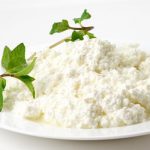
Galotiri is one of the oldest traditional cheese of Greece with Protected designation of Origin (PDO). It is manufactured from ewe’s or goat’s milk or mixtures in the regions of Epirus and Thessalia. It has a soft and spreadable texture with sour and very pleasant refreshing taste and is consumed as table cheese. The mean composition of Galotiri is: moisture 70.8%, fat 13.8%, protein 9.8%, salt 2.7% and pH 4.1.
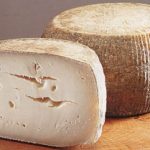
Graviera of Crete is traditional Greek cheese with Protected designation of Origin (PDO) which is exclusively manufactured in Crete from ewe's milk or mixtures with small quantities of goat's milk. It is ripened for at least for 5 months. Graviera of Crete is a high quality hard cheese of propionic fermentation with a slightly sweet taste and very pleasant organoleptic properties. It is consumed as table cheese. Graviera of Crete must contain moisture up to 38%, fat in dry matter at least 40% and salt not more than 2%.

Graviera of Naxos is traditional Greek Cheese with Protected designation of Origin (PDO). It is manufactured from cow's milk or mixtures of it with small quantities of ewe's or Goat's milk in the island of Naxos. It is a hard cheese of propionic fermentation which is ripened for at least for 3 months. It is considered to be a cheese of high quality with unique organoleptic properties and is consumed as table cheese. Graviera of Naxos must contain up to 38% moisture and fat in dry matter at least 40%.

Kalathaki of Limnos is traditional Greek cheese with Protected designation of Origin (PDO). It is manufactured from ewe’s milk or mixtures with small quantities of goat’s milk in Limnos island. Kalathaki has soft texture, slightly sour and salty taste and pleasant organoleptic properties, similar to those of Feta cheese. It is consumed as table cheese, in Greek salad, in cheese-pastries and very often as «saganaki» (shallow-fried cheese). The mean composition of Kalathaki of Limnos is : moisture 53.6%, fat 25.3%, protein 17.4%, salt 2.4% and pH 4.5.

Kasseri is traditional Greek cheese, of ?pasta filata? type, with Protected designation of Origin (PDO). It is manufactured from ewe’s milk or a mixture with goat’s milk in the regions of Macedonia, Thessalia, Mitilini Island and Xanthi. Kasseri is a semi-hard cheese which is consumed as table cheese or used in the preparation of pizza. The mean composition of Kasseri is : moisture 42.2%, fat 25.2%, protein 25.8%, salt 3.1% and pH 5.7.

Kefalograviera is traditional Greek hard cheese with Protected designation of Origin (PDO) which is manufactured from ewe’s milk in the regions of Western Macedonia, Epirus, Etoloakarnania and Evritania. As the name of the cheese indicates, its organoleptic properties stand between Kefalotiri and Graviera cheese. It ripens at least for 3 months and is consumed as table cheese, grated cheese, and quite often as «saganaki» (shallow-fried cheese). The mean composition of Kefalograviera is: moisture 35.4%, fat 31.3%, protein 25.9%, salt 3.4% and pH 5.6.
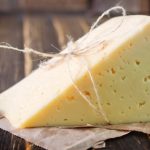
Kefalotiri is traditional Greek cheese with Protected designation of Origin (PDO), the long history and name of which are intimately connected with the customs and dietary habits of the Greeks. It is manufactured from ewe's or goat's milk or mixture of the two in the regions of Macedonia, Sterea Hellas, Peloponissos, Thessalia, Crete island, Epirus, lonian islands and Cyclades islands. Kefalotiri is considered the ancestor of many hard Greek cheeses. It has a salty and piquant taste and a unique rich aroma which is obtained after ripening for at least 3 months. It is consumed as table cheese, grated cheese, in cheese-pastries and as saganaki (shallow-fried cheese). The mean composition of Kefalotiri is: moisture 36.3%, fat 28.8%, proteins 26.6%, salt 3.9% and pH 5.1.

Kopanisti is traditional Greek cheese with Protected designation of Origin (PDO) which is exclusively manufactured in Cyclades islands from ewe’s, cow’s or goat’s milk or mixtures. The main characteristics of Kopanisti are the intense salty and piquant taste and the soft texture and rich flavor which approaches that of Roquefort. It is consumed as table cheese, in cheese-pastries and as a snack with wine and ouzo. The mean composition of Kopanisti is: moisture 60.2%, fat 19.4%, protein 16.7%, salt 3% and pH 4.6.

Traditional Greek cheese with Protected designation of Origin (PDO) which is exclusively manufactured in Mitilini island from ewe’s milk or mixture of it with goat’s milk. It is ripened for at least 3 months and is also known with the name “Kefalaki” (small head) due to its particular shape. The main characteristic of this traditional cheese is that is preserved in olive oil and this is the reason why is called Ladotiri (ladi=olive oil, tiri=cheese). It has strong flavor, hard texture with slightly salty taste and is mainly consumed as table cheese. The mean composition of Ladotiri is: moisture 33.6%, fat 31.6%, protein 2.7% and pH 5.3.
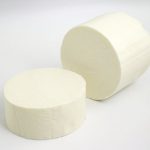
Manouri is the most exceptional traditional Greek whey cheese with Protected designation of Origin (PDO). It is exclusively manufactured in Central and Western Macedonia and in Thessalia from whey derived from ewe’s or goat’s or mixture of them, with the addition of milk and/or cream (in larger percentages than these used for anthotiros), when making hard cheeses. Manouri is a soft cheese with unique taste and flavor. The mean composition of Manouri is: moisture 51.9%, fat 36.7%, proteins 10.9%, salt 0.8% and pH 5.9.
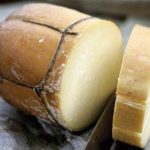
Metsovone is traditional Greek cheese with Protected designation of Origin (PDO). It is a hard smoked cheese, which is produced in the regions of Metsovo (Epirus) from where the name derives. Metsovone is considered as an excellent quality table cheese. It is manufactured from cow’s milk but mixtures with small quantities of ewe’s or goat’s milk are also used. It is ripened for at least 3 months. The mean composition of Metsovone is: moisture 41.8%, fat 25.9%, protein 26.8%, salt 2.8% and pH5.5.
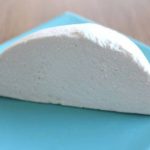
Traditional Greek whey cheese with Protected designation of Origin (PDO). It has been manufactured in Greece for thousands of years and is considered the ancestor of all Greek whey cheeses. Mizithra is manufactured from whey derived from ewe’s, goat’ s or cow’s milk or mixtures of milks in the regions of Macedonia, Thrace, Thessalia, Sterea Hellas, Peloponissos, Ionian islands, Aegean island and Crete island. There are two types of Mizithra; Fresh Mizithra which is unsalted or slightly salted and consumed a few hours or days after its manufacture and Dried Mizithra which is salted, dried and consumed as grated cheese. Fresh Mizithra contains up to 70% moisture and at least 50% fat in dry matter, while Dried Mizithra contains 40% and 50%, respectively.


